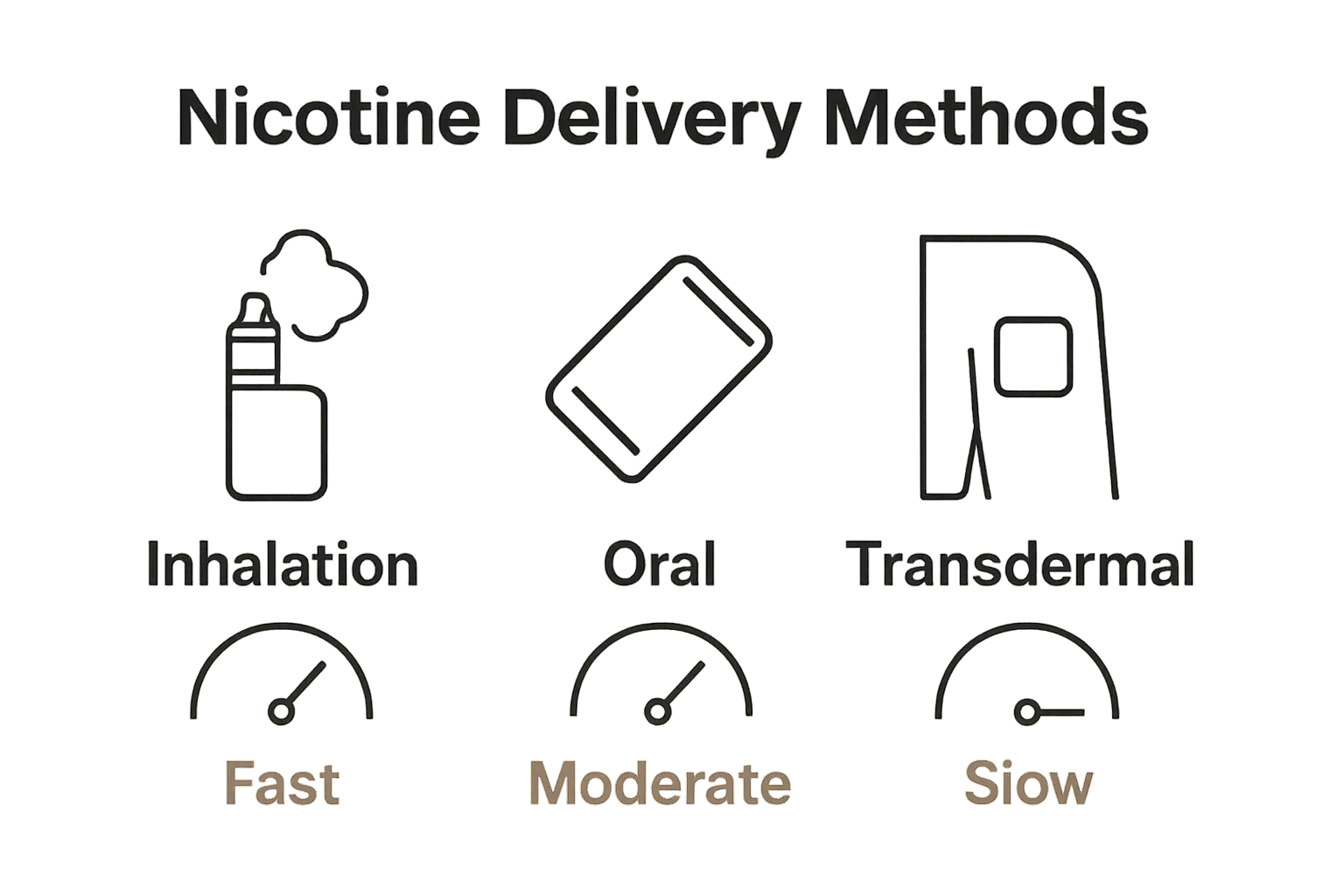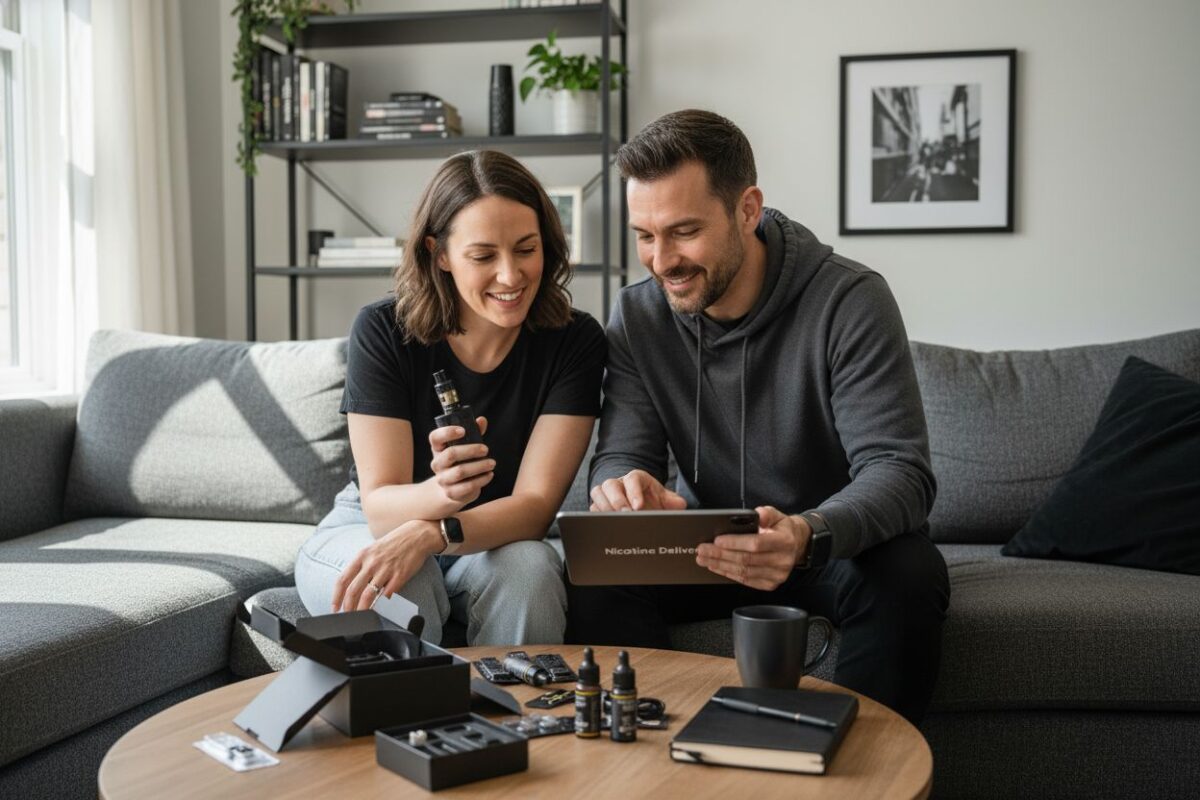Uncategorized
Understanding Why Nicotine Delivery Matters in Vaping
Nicotine delivery shapes how millions experience products like cigarettes, e-cigarettes, and nicotine pouches every day. You might think that all nicotine hits feel the same, but the way nicotine enters the body can actually change its impact on your brain and satisfaction level entirely. In fact, inhalation sends nicotine into the bloodstream faster than any other method and that difference is what makes some products feel instantly powerful while others are slow and steady.
Table of Contents
- What Is Nicotine Delivery And How Does It Work?
- The Importance Of Nicotine Delivery In Consumer Experience
- How Nicotine Delivery Influences Product Design
- The Scientific Basis Of Nicotine Absorption And Delivery
- Real-World Implications Of Nicotine Delivery In Vaping
Quick Summary
| Takeaway | Explanation |
|---|---|
| Nicotine delivery impacts absorption speed. | Inhalation provides the fastest absorption method, affecting the user’s experience significantly. |
| Personalized nicotine absorption is crucial. | Different users have unique tolerances and preferences, making tailored delivery methods essential for satisfaction. |
| Technological advancements enhance user experience. | Modern nicotine delivery systems prioritize control and personalization, improving overall consumption experiences. |
| Public health benefits from controlled delivery. | Advanced nicotine delivery methods offer lower exposure to harmful substances compared to traditional smoking. |
| Regulatory frameworks are evolving with technology. | As nicotine delivery systems advance, regulations adapt to accommodate their potential as harm reduction tools. |
What is Nicotine Delivery and How Does it Work?
Nicotine delivery represents a critical mechanism by which nicotine enters the human body, enabling users to experience the substance’s physiological and psychological effects. Understanding this process goes beyond simple consumption, involving complex biochemical interactions that determine how quickly and effectively nicotine reaches the bloodstream and brain.
The Biological Mechanism of Nicotine Absorption
When nicotine enters the body, it undergoes a sophisticated absorption process that varies significantly depending on the delivery method. According to research from the National Institute on Drug Abuse, nicotine is rapidly absorbed through mucous membranes, lung tissue, and the skin, creating different onset speeds and intensity levels.
The primary routes of nicotine delivery include:

- Inhalation: Fastest absorption method, delivering nicotine directly into the bloodstream through lung tissues
- Oral Absorption: Slower absorption through mucous membranes in the mouth and throat
- Transdermal: Gradual absorption through skin patches
Physiological Impact and Receptor Interaction
Nicotine delivery matters because of its profound interaction with the human nervous system. When nicotine enters the bloodstream, it quickly crosses the blood brain barrier and binds to nicotinic acetylcholine receptors. These receptors are widespread throughout the nervous system, triggering complex neurochemical responses that influence mood, concentration, and stress levels.
The speed and efficiency of nicotine delivery determine the user’s experience. Faster delivery methods like vaping and smoking produce more immediate neurological responses compared to slower absorption techniques. This rapid interaction explains why some nicotine consumption methods feel more satisfying or provide more instant gratification.
Below is a table comparing different nicotine delivery methods, summarizing their absorption rates, delivery speed, and user experience as discussed in the article.
| Delivery Method | Absorption Rate | Delivery Speed | Typical User Experience |
|---|---|---|---|
| Inhalation | High | Very fast | Immediate satisfaction, strong effect |
| Oral Absorption | Moderate | Slower | Gradual onset, sustained comfort |
| Transdermal | Low | Slowest | Steady, controlled, less immediate |
Technology and Delivery Innovations
Modern nicotine delivery systems have evolved significantly, focusing on precision, user experience, and harm reduction. Scientific research from the Royal College of Physicians demonstrates how technological advancements have transformed nicotine consumption, creating more controlled and potentially less harmful delivery mechanisms.
Understanding nicotine delivery is crucial for consumers, health professionals, and researchers seeking to comprehend the complex interactions between nicotine and human physiology. The ongoing technological and scientific developments continue to reshape our understanding of how this powerful compound impacts the human body.
The Importance of Nicotine Delivery in Consumer Experience
Nicotine delivery profoundly influences user satisfaction, product selection, and overall consumption experience across various nicotine products. Understanding these nuanced interactions helps consumers and manufacturers develop more effective and personalized nicotine consumption strategies.
Consumer Satisfaction and Product Performance
The quality of nicotine delivery directly correlates with user satisfaction and product effectiveness. Research from the Journal of Addiction demonstrates that users prioritize delivery speed, consistency, and sensory experience when selecting nicotine products. These factors determine whether consumers perceive a product as satisfying or continue seeking alternative delivery methods.

Key performance indicators for nicotine delivery include:
- Absorption Rate: Speed of nicotine entering the bloodstream
- Nicotine Concentration: Total amount of nicotine delivered per session
- Consistency: Uniform nicotine experience across different usage instances
Physiological and Psychological Matching
Successful nicotine delivery requires precise alignment with individual physiological and psychological needs. Personalized nicotine absorption plays a critical role in determining user satisfaction. Different consumers have varying nicotine tolerances, metabolism rates, and psychological responses, making customized delivery mechanisms essential.
Some users prefer rapid nicotine delivery for immediate stress relief, while others seek gradual absorption for sustained comfort. This diversity underscores the importance of flexible and adaptable nicotine delivery technologies read more about our nicotine solutions.
Technological Innovation and User Experience
Modern nicotine delivery systems focus on creating more sophisticated, user-centric experiences. Emerging technologies aim to provide precise nicotine dosing, reduced health risks, and enhanced user control. These innovations represent a significant shift from traditional consumption methods, prioritizing user experience and harm reduction.
The continuous evolution of nicotine delivery technologies reflects a deeper understanding of consumer needs, biochemical interactions, and personalized consumption preferences. By focusing on refined delivery mechanisms, manufacturers can develop products that offer more satisfying, controlled, and potentially less harmful nicotine experiences.
How Nicotine Delivery Influences Product Design
Nicotine delivery mechanisms fundamentally reshape product design strategies across vaping and alternative nicotine technologies. Manufacturers continuously adapt their product development approaches to optimize nicotine absorption, user experience, and consumer satisfaction.
Engineering Nicotine Absorption Technologies
Research from the Tobacco Control journal highlights how nicotine delivery considerations drive sophisticated engineering decisions. Product designers must balance multiple complex factors, including absorption rate, concentration precision, and user comfort.
Key design considerations for nicotine delivery technologies include:
- Molecular Structure: Manipulating nicotine compounds to enhance absorption
- Device Ergonomics: Creating intuitive interfaces that facilitate efficient nicotine transfer
- Material Selection: Choosing substances that optimize heat distribution and vapor production
Performance and User Experience Optimization
Nicotine delivery directly influences product performance metrics. Technological innovations now focus on creating more refined, controlled nicotine experiences that meet diverse user preferences. Some designs prioritize rapid absorption for immediate satisfaction, while others emphasize gradual, sustained nicotine release explore our nicotine gum solutions.
Designers must consider physiological variations among users, developing products that accommodate different metabolic rates, tolerance levels, and psychological responses. This approach transforms nicotine delivery from a standardized process to a personalized experience.
Regulatory Compliance and Safety Innovations
Nicotine delivery mechanisms increasingly drive product safety and regulatory compliance. Modern design philosophies emphasize harm reduction, implementing advanced technologies that minimize potential health risks while maintaining user satisfaction.
Advanced product designs now incorporate sophisticated monitoring systems, precise dosage controls, and intelligent feedback mechanisms.
This table highlights key design considerations for nicotine delivery technologies, organizing information from the product design section for quick reference.
| Design Consideration | Purpose | Example as Discussed |
|---|---|---|
| Molecular Structure | Enhance absorption and bioavailability | Manipulating nicotine compounds |
| Device Ergonomics | Improve ease of use and efficient nicotine transfer | Intuitive device interfaces |
| Material Selection | Optimize heat distribution and vapor production | Advanced heating and wick materials |
The Scientific Basis of Nicotine Absorption and Delivery
Nicotine absorption represents a complex biochemical process involving intricate interactions between molecular structures, physiological systems, and delivery mechanisms. Understanding the scientific foundations of this process provides critical insights into how nicotine impacts human biology and influences consumption experiences.
Molecular Interactions and Receptor Dynamics
Research from the Pharmacological Reviews journal reveals the sophisticated neurochemical interactions underlying nicotine absorption. Nicotine molecules possess a unique structural configuration that allows them to rapidly penetrate biological membranes and bind with specialized nicotinic acetylcholine receptors throughout the nervous system.
Key molecular characteristics of nicotine absorption include:
- Lipid Solubility: Enables rapid cellular membrane penetration
- Molecular Size: Facilitates quick blood brain barrier crossing
- Electrical Charge: Determines interaction speed with neural receptors
Physiological Absorption Pathways
Bioavailability varies significantly across different nicotine delivery methods. Inhalation provides the most direct and rapid absorption pathway, with nicotine molecules traveling directly through lung tissues into the bloodstream. Oral and transdermal methods involve more complex metabolic processing, resulting in slower and more gradual nicotine release learn more about our nicotine absorption technologies.
The human body processes nicotine through multiple metabolic pathways, with the liver playing a crucial role in breaking down and eliminating nicotine compounds. Individual variations in metabolism, genetic factors, and physiological conditions can dramatically influence nicotine absorption rates and overall effectiveness.
Neurological Response and Biochemical Signaling
Nicotine triggers complex neurochemical responses by mimicking acetylcholine, a critical neurotransmitter. When nicotine binds to neural receptors, it stimulates the release of various neurotransmitters, including dopamine, which contributes to the substance’s psychological and physiological effects.
Scientific understanding of nicotine absorption continues to evolve, with emerging research focusing on developing more precise, personalized delivery mechanisms that maximize efficiency while minimizing potential health risks. This ongoing scientific exploration represents a critical frontier in understanding human neurochemistry and consumption behaviors.
Real-World Implications of Nicotine Delivery in Vaping
Nicotine delivery in vaping transcends technological innovation, directly impacting public health, consumer behavior, and regulatory frameworks. Understanding these real-world implications helps stakeholders make informed decisions about product development, usage, and policy implementation.
Public Health and Harm Reduction
Research from the Public Health journal demonstrates that nicotine delivery mechanisms play a crucial role in harm reduction strategies. Advanced vaping technologies offer potentially less harmful alternatives to traditional combustible tobacco products, with more controlled nicotine absorption and reduced toxic chemical exposure.
Key public health considerations include:
- Reduced Chemical Exposure: Lower levels of harmful combustion byproducts
- Controlled Nicotine Intake: Precise dosage management capabilities
- Potential Smoking Cessation Tool: Alternative for individuals seeking to reduce tobacco consumption
Consumer Behavior and Social Dynamics
Nicotine delivery technologies fundamentally reshape consumer interactions with nicotine products. Modern vaping devices provide unprecedented levels of personalization, allowing users to fine-tune their nicotine experience explore our comprehensive product range.
The emergence of sophisticated nicotine delivery systems has transformed social perceptions of nicotine consumption. Users now view vaping as a technologically advanced, potentially less harmful alternative to traditional smoking, reflecting broader shifts in consumer attitudes towards nicotine products.
Regulatory and Economic Implications
As nicotine delivery technologies evolve, regulatory bodies worldwide are developing more nuanced approaches to product oversight. Governments and health organizations increasingly recognize the potential of advanced nicotine delivery systems as harm reduction tools, leading to more sophisticated regulatory frameworks.
Economic implications extend beyond individual product sales, influencing healthcare costs, tobacco industry dynamics, and public health expenditures. The continuous refinement of nicotine delivery mechanisms represents a significant intersection of technological innovation, consumer health, and regulatory policy.
Ready to Experience Advanced Nicotine Delivery?
Are you struggling to find vaping solutions that provide consistent absorption, quick satisfaction, and a smoother experience like those described in this article? Alibarbar understands how vital fast, effective nicotine delivery is for your comfort and well-being. Our range is built on the same cutting-edge research and technological insights highlighted above. If you are interested in even more resources on vape delivery innovation, explore our Uncategorized Archives for insider knowledge and updates straight from the experts.

Stop settling for less when it comes to your nicotine satisfaction. Discover Alibarbar and see why our disposable vapes and smokeless nicotine products stand out for speed, purity, and taste. Act now to enjoy the benefits of breakthrough technology and a global standard of safety. Shop with us today and redefine your personal vaping experience.
Frequently Asked Questions
What is nicotine delivery, and why does it matter in vaping?
Nicotine delivery refers to how nicotine enters the body and reaches the bloodstream, which significantly impacts user satisfaction and the physiological effects experienced during vaping.
How do different nicotine delivery methods affect the user experience?
Different methods—such as inhalation, oral absorption, and transdermal delivery—vary in speed and intensity. Inhalation provides the fastest absorption, resulting in a more immediate effect compared to slower methods like oral or transdermal delivery.
Why is the absorption rate important when choosing nicotine products?
The absorption rate affects how quickly nicotine enters the bloodstream, which can influence user satisfaction. Many consumers prefer products that deliver nicotine rapidly for a more intense and immediate experience.
How do technological innovations impact nicotine delivery systems?
Advancements in technology focus on enhancing user experience by offering precise nicotine dosing, improved safety features, and customizable delivery methods, which may lead to a potentially less harmful means of nicotine consumption.
Recommended
Article generated by BabyLoveGrowth

